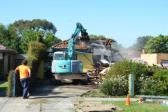
When demolition is taking place, dust and debris can create a hazard on neighbouring properties. Learn more about the sorts of measures that are normally taken to isolate a demolition site from other properties.

Image by Chris Hill.
When demolition work’s being carried out, it’s important that any adjoining structures or properties are protected against incidental damage. Creating as little disturbance as possible is obviously a high priority, and there are a variety of measures that need to be taken to ensure that this is the case.
It’s the owner’s obligation under the Building Act 1993 and the Building Regulations 2006 to ensure that adjoining property is protected from potential damage as a result of work being carried out.
What is the process for protection of adjoining properties?
When you submit your application for a building permit, it goes to a person known as the ‘building surveyor’. The building surveyor is tasked with assessing your permit in accordance with the Building Code of Australia, and is the person who will decide what types of protections, if any, are needed for adjoining properties.
What happens with neighbours?
Once the necessary measures have been determined by the building surveyor, a Protection of Adjoining Property Work Notice or similar will be served on the owner of the adjoining property. A contract of insurance will need to be obtained, and a survey of the property will be prepared.
Your neighbours will normally have 14 days in which to either agree to or disagree with the proposed protection measures, or to ask for more details. Once the details are determined they will also need to help arrange a survey of their property.
People on these adjoining properties can also seek reimbursement for any reasonable expenses that arise out of measures to protect their property during the construction process.
What does protection of adjoining properties involve?
The kinds of measures that are likely to be required for the protection of adjoining properties include things like:
- preventing demolished materials or dust from encroaching on adjoining properties
- temporary supports (if they’re required) for existing buildings to prevent damage from vibration or concussion
- temporary weatherproofing measures
- temporary access and security measures
- noise, fume, smoke and other environmental controls
For more information on the sorts of measures that are likely to be needed, talk to your builder or a demolition specialist.





